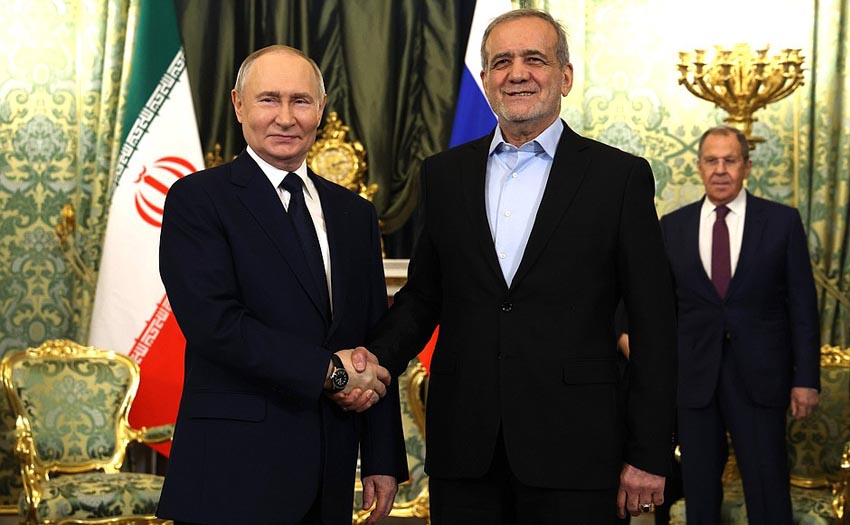Iran and Russia have officially started to implement a 20-year comprehensive strategic partnership treaty, signalling a significant step towards deepening bilateral ties between the two countries, the Russian Foreign Ministry said in a statement on
Thursday.
The Russian Foreign Ministry said: ‘The Comprehensive Strategic Partnership Treaty between the Russian Federation and the Islamic Republic of Iran, signed by Russian President Vladimir Putin and Iranian President Masoud Pezeshkian in Moscow on 17th January, 2025, became effective on 2nd October.’
The treaty, it added, is a sign of the ‘strategic choice’ made by the two countries’ political leadership toward improving the friendly and good neighbourly relations to serve core mutual interests.
According to the ministry, the agreement’s coming into force ‘marks an important milestone in the history of Russian-Iranian interstate relations that have reached a new level of broad strategic partnership.’
It noted that the treaty sets key benchmarks for priority spheres of long-term bilateral cooperation.
The Russian ministry stated: ‘Among other things, it envisages efforts to strengthen cooperation in the international arena amid the evolving multipolar world order, including close coordination at major multilateral associations, and joint efforts toward consolidating stability and security in the region and countering common challenges and threats.’
Iran’s Parliament in May approved the treaty with Russia by consensus after Russia’s lower house of parliament ratified the pact in April.
Based on the treaty, Russia and Iran are committed to helping each other counter common ‘security threats’ and exchange intelligence in that direction.
The agreement also stipulates that if either side is subjected to aggression, the other will not provide ‘assistance to the aggressor’.
Iran and Russia, as two close and strategic allies, have deepened relations in various fields, despite heavy Western sanctions.
Meanwhile, the supplies of US-made Tomahawk cruise missiles to Kiev, if they take place, will signify a serious escalation of tension in the Ukraine conflict and require Moscow’s adequate response, Kremlin spokesman Dmitry Peskov said in a statement on Thursday.
Peskov stated: ‘Indeed, representatives of the US leadership spoke in an interview this week about possible supplies of such missiles and, generally, quite admitted of the possibility of strikes deep inside Russian territory.
‘This is, of course, quite a dangerous symptom and it cannot be unnoticed by Moscow.
‘We have noticed it. And if this happens, this will mean a new serious escalation of tension that will require an adequate response from the Russian side.’
US Vice President JD Vance stated earlier that the Washington administration was considering providing Tomahawk cruise missiles to other NATO countries for a subsequent transfer to Ukraine. According to him, the final decision on the matter will be made by US President Donald Trump.
- The European Investment Bank (EIB) will provide the Ukrainian company Naftogaz with a 300 million euros loan to purchase gas for the upcoming heating season, Naftogaz’s press service reported.
A Naftogaz statement said: ‘Naftogaz Group has signed a landmark 300 million euros loan agreement with the European Investment Bank (EIB).
The financing will be used to purchase gas to build long-term gas reserves and to ensure stable winter supplies for Ukrainians.
Under the terms of the agreement, Naftogaz ‘pledges to reinvest an amount equivalent to the EIB loan into renewable energy and decarbonisation projects’.
The document was signed in the presence of Ukrainian Minister of Economy, Environment, and Agriculture Alexey Sobolev and European Commissioner for Enlargement Marta Kos during her visit to Kiev.
During the last heating season, Ukraine pumped almost all the gas from its storage facilities, including the technical gas needed to maintain pipeline pressure.
Following Kiev’s decision not to renew its agreement with Gazprom on January 1 and the halting of Russian gas transit to Europe through the Ukrainian gas transmission system, Naftogaz began increasing its gas imports from EU countries at high market prices. The heating season ended ahead of schedule.
In early September, Sergey Nagornyak, a member of the relevant Verkhovna Rada committee, said that Kiev needed to find over 2.5 billion euros (£2.2 billion) to purchase 5.5 million cubic metres of gas to ensure the upcoming season. Naftogaz, he said, ‘is begging all over the world’.
- Camp Jomsborg, a new training facility for Ukrainian troops, has opened at the Polish Army’s training centre in Nowa Deba, in the Podkarpackie Region of southeastern Poland.
The opening ceremony was attended by the defence ministers of Poland, Norway, and Estonia – Wladyslaw Kosiniak-Kamysz, Tore Sandvik, and Hanno Pevkur. Norway initiated the camp’s construction.
According to Kosiniak-Kamysz, the facility can train about 1,200 military personnel at a time. Poland’s Defence Ministry reported that since 2022, more than 32,000 Ukrainian troops have received training in the country.
The European Commission (EC) allocated a new tranche for Ukraine from the seized Russian assets, the Commission said in its press release.
The EC said: ‘The European Commission has disbursed the ninth tranche of its exceptional Macro-Financial Assistance (MFA) loan to Ukraine, worth 4 billion euros (£3.5 billion).’
This amount was allocated from revenues from frozen Russian assets. According to the Commission, funds will be directed to support the defence sector, with two billion euros earmarked to buy drones.
The Ukrainian army lost 1,510 troops in battles from Wednesday though to Thursday according to data released from the Russian Foreign Ministry on Thursday.
The worst hit area for the Ukrainian troops was in the centre of the Donbass region with 200 lost in the north.
290 Ukraine troops were lost in the east, 230 killed in the west of the Donetsk region and 235 troops were lost in the south.
